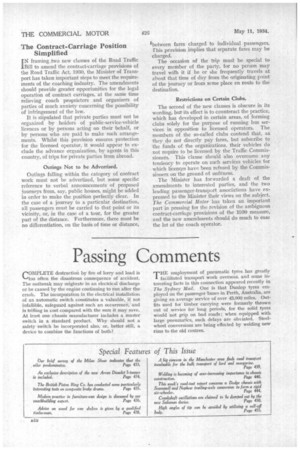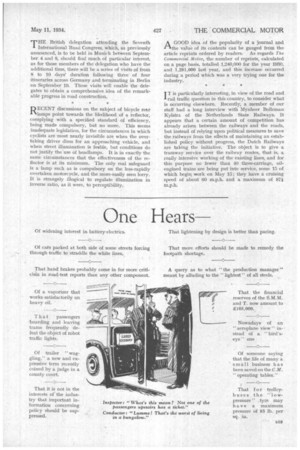Passing Comments
Page 36

Page 37

If you've noticed an error in this article please click here to report it so we can fix it.
COMPLETE destruction by fire of lorry and load is too often the disastrous consequence of accident. The outbreak may originate in an electrical discharge or be caused by the engine continuing to run after the crash. The incorporation in the electrical installation of an automatic switch constitutes a valuable, if not infallible, safeguard against such an occurrence, and is trifling in cost compared with the sum it may save. At least one chassis manufacturer includes a master switch in a standard product. Why should not a safety switch be incorporated also, or, better still, a device to combine the functions of both? THE employment of pneumatic tyres has greatly facilitated transport work overseas, and some interesting facts in this connection appeared recently in , The Sydney Mail. One is that Dunlop tyres employed on the passenger buses in Perth, Australia, are giving an average service of over 43,000 miles. Outfits used for timber carrying were formerly thrown out of service for long periods, for the solid tyres would not grip on bad roads; when equipped with large pneumatics, such delays are obviated. Steelwheel conversions are being effected by welding new rims to the old centres. THE British delegation attending the Seventh I International Road Congress, which, as previously announced, is to be held in Munich between September 4 and 8, should find much of particular interest, as for those members of the delegation who have the additional time, there will be a series of visits of from 8 to 10 days' duration following three of four itineraries across Germany and terminating in Berlin on September 19. These visits will enable the delegates to obtain a comprehensive idea of the remarkable progress in road construction.
RECENT discussions on the subject of bicycle rear
lamps point towards the likelihood of a reflector, complying with a specified standard of efficiency, being made compulsory, but no more. This seems inadequate legislation, for the circumstances in which cyclists are most nearly invisible are when the overtaking driver dims for an approaching vehicle, and when street illumination is feeble, but conditions do not justify the use of headlamps. It is in exactly the same circumstances that the effectiveness of the reflector is at its minimum. The only real safeguard is a lamp such as is compulsory on the less-rapidly overtaken motorcycle, and the more-easily seen lorry. It is strangely illogical to regulate illumination in inverse ratio, as it were, to perceptibility.
A GOOD idea of the popularity of a journal and 1-1the value of its contents can be gauged from the article reprints ordered by readers. As regards The Commercial Motor, the number of reprints, calculated on a page basis, totalled 1,240,000 for the year 1930, and 1,281,000 last year, and this increase occurred during a period which was a very trying one for the industry.
T T is particularly interesting, in view of the road and I rail traffic question in this country, to consider what is occurring elsewhere. Recently, a member of our staff had a long interview with Myriheer Bolleman Kylstra of the Netherlands State Railways. It appears that a certain amount of competition has already arisen between the railways and the roads, but instead of relying upon political measures to save the railways from the effects of maintaining an established policy without progress, the Dutch Railways are taking the initiative. The object is to give a tramway service over the railway routes, that is, a really intensive working of the existing lines, and for this purpose no fewer than 40 three-carriage, oileng,ined trains are being put into service, some 15 of which begin work on May 15; they have a cruising speed of about 60 m.p.h. and a maximum of 871. m.p.h.




































































































